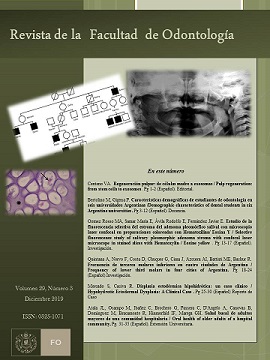Selective fluorescence study of salivary pleomorphic adenoma stroma with confocal laser microscope in stained slices with Hematoxylin / Eosine yellow
Keywords:
photonic microscope,confocal laser scanning microscope, H/E, fluorescence, pleomorphic adenoma, stromaAbstract
Introduction: The pleomorphic adenoma (PA) is a benign salivary gland tumor. It has ductal cells,myoepitheliocytes and a stroma with hyalinised, myxoid and chondroid metaplasia zones. On the other hand, the H/ E gives an integral view of the tissue structure. Hematoxylin acts as a basic dye that stains violet. The eosin is an artificial acid dye that stains pink eosinophilic structures. The Eosina Y is strongly fluorescent, which allows to identify with the confocal laser microscope eosinophilic structures that are sometimes little visible to the photonic microscope. Objective: The PA chondroid stroma was analyzed with photonic and confocal scanning laser microscopes to demonstrate the value of the fluorescence emitted by Eosin Y in its structural description. Material & Methods: The histological examination of 10 PA parotid stained with H/E Y was performed. The images of the histological preparations were obtained by means of a photonic optical microscope and a FV1000 Olympus spectral confocal laser microscope, configured for the acquisition of orange / red fluorescence of the Eosin obtained between 555 to 655 nm. The eosin was excited at 543 nm using the He-Ne gas laser. Results: Photonic microscopy: The chondroid tumor areas presented a variable extension predominantly in only 4 cases. Histologically, these areas looked like immature hyaline cartilage, a chondroid type with an amorphous-like basophilic extracellular matrix and lacunae with round or oval chondroidocytes. * Scanning confocal laser microscopy: structures with strong red fluorescence were observed swollen in the extracellular matrix, the pericellular capsule of the chondroidocytes and the collagen of the territorial and inter-territorial matrices. Conclusions: The confocal laser scanning microscope allows visualizing structures in PA slides stained with H/E Y not visible to the clear field. We highlight the usefulness of H/E Y in histopathology both in photonic microscopy and confocal laser scanning microscopy.
References
1. Chan JKC. The wonderful colors of the Hematoxylin-Eosin stain in diagnostic surgical pathology. Int J Surg Pathol 2014; 22/1: 12-32.
2. Samar ME, Avila RE, Esteban Ruiz F. Técnicas histológicas. Fundamentos y aplicaciones. Córdoba: Editorial SeisC. 2004.
3. Lahiani A, Klaiman E, Grimm O. Enabling histopathological annotations on immunofluorescent images through virtualization of Hematoxilyn and Eosin. J Pathol Inform 2018; 9: doi:10.4103/jpi.jpi_61_17.
4. Samar ME, Avila RE, Histología humana clínicamente orientada. Tejidos y sistemas. 5º edición. Córdoba: Samar ediciones. 2016.
5. Hamid A, Saldar A, Maryam M, Amjard A, Azra J, Abid A. Eosin fluorescence: A diagnostic tool for quantification of liver injuri. Photodiag Photodynam Therapy 2017; 19: 37-44.
6. Sánchez González J, Trejo Bahena NI, Vázquez Moctezul I, Martínez Martínez CM, Ortega Rangel JA. Fluorescencia de la eosina captada por microscopía confocal en cortes histológicos de piel. Actas Dermatol 2008; 7: 41-47.
7. Ellis GL, Auclair PL. Tumors of salivary glands. Washington, DC: American Registry of Pathology Armed Forces Institute of Pathology. 2008.
8. Organización Mundial de la Salud. WHO/IARC. Classification of Head and Neck Tumours. 4th ed. WHO. Lyon: Edited by El-Naggar AK, Chan JKC, Grandis JR, Takata T, Slootweg PJ. 2017.
9. Samar ME, Avila RE.Tumores Epiteliales de Glándulas Salivales. Saarbrücken. Alemania: Editorial Académica Española. 2013.
10. Satpathy Y, Spadigam AE, Duphar A,k Syed S. Epithelial and stromal patterns of pleomorphic adenoma of minor salivary glands: A histopathological and histochemical study. J Oral Maxillofac Pathol 2014; 18: 379-385.
11. Amaina systems. La Eosina Y. https://www.amaina.com/tinturas-y-compuestos/2179-tintura-eosina-y-25-ml-euromex-pb5283.html (último acceso: 7 de agosto de 2019).
Published
Issue
Section
License
Aquellos autores/as que tengan publicaciones con esta revista, aceptan los términos siguientes:
- Los autores/as conservarán sus derechos de autor y garantizarán a la revista el derecho de primera publicación de su obra, el cuál estará simultáneamente sujeto a la Licencia de reconocimiento de Creative Commons que permite a terceros:
- Compartir — copiar y redistribuir el material en cualquier medio o formato
- La licenciante no puede revocar estas libertades en tanto usted siga los términos de la licencia
- Los autores/as podrán adoptar otros acuerdos de licencia no exclusiva de distribución de la versión de la obra publicada (p. ej.: depositarla en un archivo telemático institucional o publicarla en un volumen monográfico) siempre que se indique la publicación inicial en esta revista.
- Se permite y recomienda a los autores/as difundir su obra a través de Internet (p. ej.: en archivos telemáticos institucionales o en su página web) después del su publicación en la revista, lo cual puede producir intercambios interesantes y aumentar las citas de la obra publicada. (Véase El efecto del acceso abierto).

